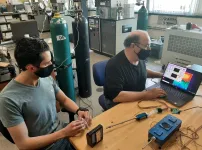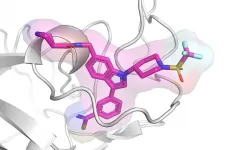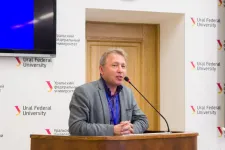New research optimizes body's own immune system to fight cancer
First-of-its-kind study shows how engineered immune cells move faster to attack the tumor
2021-05-14
(Press-News.org) A groundbreaking study led by engineering and medical researchers at the University of Minnesota Twin Cities shows how engineered immune cells used in new cancer therapies can overcome physical barriers to allow a patient's own immune system to fight tumors. The research could improve cancer therapies in the future for millions of people worldwide.
The research is published in Nature Communications, a peer-reviewed, open access, scientific journal published by Nature Research.
Instead of using chemicals or radiation, immunotherapy is a type of cancer treatment that helps the patient's immune system fight cancer. T cells are a type of white blood cell that are of key importance to the immune system. Cytotoxic T cells are like soldiers who search out and destroy the targeted invader cells.
While there has been success in using immunotherapy for some types of cancer in the blood or blood-producing organs, a T cell's job is much more difficult in solid tumors.
"The tumor is sort of like an obstacle course, and the T cell has to run the gauntlet to reach the cancer cells," said Paolo Provenzano, the senior author of the study and a biomedical engineering associate professor in the University of Minnesota College of Science and Engineering. "These T cells get into tumors, but they just can't move around well, and they can't go where they need to go before they run out of gas and are exhausted."
In this first-of-its-kind study, the researchers are working to engineer the T cells and develop engineering design criteria to mechanically optimize the cells or make them more "fit" to overcome the barriers. If these immune cells can recognize and get to the cancer cells, then they can destroy the tumor.
In a fibrous mass of a tumor, the stiffness of the tumor causes immune cells to slow down about two-fold--almost like they are running in quicksand.
"This study is our first publication where we have identified some structural and signaling elements where we can tune these T cells to make them more effective cancer fighters," said Provenzano, a researcher in the University of Minnesota Masonic Cancer Center. "Every 'obstacle course' within a tumor is slightly different, but there are some similarities. After engineering these immune cells, we found that they moved through the tumor almost twice as fast no matter what obstacles were in their way."
To engineer cytotoxic T cells, the authors used advanced gene editing technologies (also called genome editing) to change the DNA of the T cells so they are better able to overcome the tumor's barriers. The ultimate goal is to slow down the cancer cells and speed up the engineered immune cells. The researchers are working to create cells that are good at overcoming different kinds of barriers. When these cells are mixed together, the goal is for groups of immune cells to overcome all the different types of barriers to reach the cancer cells.
Provenzano said the next steps are to continue studying the mechanical properties of the cells to better understand how the immune cells and cancer cells interact. The researchers are currently studying engineered immune cells in rodents and in the future are planning clinical trials in humans.
While initial research has been focused on pancreatic cancer, Provenzano said the techniques they are developing could be used on many types of cancers.
"Using a cell engineering approach to fight cancer is a relatively new field," Provenzano said. "It allows for a very personalized approach with applications for a wide array of cancers. We feel we are expanding a new line of research to look at how our own bodies can fight cancer. This could have a big impact in the future."
INFORMATION:
In addition to Provenzano, the study's authors included current and former University of Minnesota Department of Biomedical Engineering researchers Erdem D. Tabdanov (co-author), Nelson J. Rodríguez-Merced (co-author), Vikram V. Puram, Mackenzie K. Callaway, and Ethan A. Ensminger; University of Minnesota Masonic Cancer Center and Medical School Department of Pediatrics researchers Emily J. Pomeroy, Kenta Yamamoto, Walker S. Lahr, Beau R. Webber, Branden S. Moriarity; National Institute of Biomedical Imaging and Bioengineering researcher Alexander X. Cartagena-Rivera; and National Heart, Lung, and Blood Institute researcher Alexander S. Zhovmer, who is now at the Center for Biologic Evaluation and Research.
The research was funded primarily by the National Institutes of Health (NIH) and University of Minnesota Physical Sciences in Oncology Center, which receives funding from NIH's National Cancer Institute. Additional funding was provided by the American Cancer Society and the Randy Shaver Research and Community Fund. The University of Minnesota Imaging Center provided additional staff expertise. Some of the researchers also are part of the University of Minnesota Center for Genome Engineering and the University's Institute for Engineering in Medicine.
To read the full research paper entitled "Engineering T cells to enhance 3D migration through structurally and mechanically complex tumor microenvironments," visit the Nature Communications website.
ELSE PRESS RELEASES FROM THIS DATE:
2021-05-14
KINGSTON, R.I. - May 14, 2021 - We are frequently reminded of how vulnerable our health and safety are to threats from nature or those who wish to harm us.
New sensors developed by Professor Otto Gregory, of the College of Engineering at the University of Rhode Island, and chemical engineering doctoral student Peter Ricci, are so powerful that they can detect threats at the molecular level, whether it's explosive materials, particles from a potentially deadly virus or illegal drugs entering the country.
"This is potentially life-saving technology," said Gregory. "We have detected ...
2021-05-14
Researchers from Mosquito Alert (who belong to CEAB-CSIC, CREAF and UPF) together with researchers from the University of Budapest have shown that an artificial intelligence algorithm is capable of recognizing the tiger mosquito (Aedes albopictus) in the photos sent by Mosquito Alert users.
The results of the study published in Scientific Reports have been obtained by applying deep learning technology or deep learning, an aspect of artificial intelligence that seeks to emulate the way of learning of humans and that has previously been used in the health field to interpret ...
2021-05-14
Of the over 400 climate scenarios assessed in the 1.5°C report by the Intergovernmental Panel on Climate Change (IPCC), only around 50 scenarios avoid significantly overshooting 1.5°C. Of those only around 20 make realistic assumptions on mitigation options, for instance the rate and scale of carbon removal from the atmosphere or extent of tree planting, a new study shows. All 20 scenarios need to pull at least one mitigation lever at "challenging" rather than "reasonable" levels, according to the analysis. Hence the world faces a high degree of risk of overstepping the 1.5°C limit. The realistic window for meeting the 1.5°C target is very rapidly closing.
If all climate mitigation levers are pulled, it may still be possible ...
2021-05-14
The protein made by the ASH1L gene plays a key role in the development of acute leukemia, along with other diseases. The ASH1L protein, however, has been challenging to target therapeutically.
Now a team of researchers led by Jolanta Grembecka, Ph.D., and Tomasz Cierpicki, Ph.D., from the University of Michigan has developed first-in-class small molecules to inhibit ASH1L's SET domain -- preventing critical molecular interactions in the development and progression of leukemia.
The team's findings, which used fragment-based screening, followed by medicinal chemistry and a structure-based design, appear in Nature Communications.
In mouse models of mixed lineage leukemia, the lead compound, known as AS-99, successfully reduced leukemia progression.
"This ...
2021-05-14
Organizing functional objects in a complex, sophisticated architecture at the nanoscale can yield hybrid materials that tremendously outperform their solo objects, offering exciting routes towards a spectrum of applications. The development in synthetic chemistry over past decades has enabled a library of hybrid nanostructures, such as core-shell, patchy, dimer, and hierarchical/branched ones.
Nevertheless, the material combinations of these non-van der Waals solids are largely limited by the rule of lattice-matched epitaxy.
A research team led by professor YU Shuhong at the University of Science and Technology of China (USTC) has reported a new class of heteronanostructures they ...
2021-05-14
After the p53 tumour suppressor gene, the genes most frequently found mutated in cancer are those encoding two proteins of the SWI/SNF chromatin remodelling complex. This complex's function is to "accommodate" the histones that cover the DNA of the chromosomes so that the processes of transcription, DNA repair and replication or chromosome segregation can occur, as appropriate. A group from the University of Seville has demonstrated at CABIMER that the inactivation of BRG1, the factor responsible for the enzymatic activity of the SWI/SNF complexes, leads to high genetic instability, a characteristic common to the vast majority of tumours.
This study's most important contribution is that it deciphers the mechanism by which this occurs. The SWI/SNF complex ...
2021-05-14
Yoga and breathing exercises have a positive effect on children with attention deficit hyperactivity disorder (ADHD). After special classes, children improve their attention, decrease hyperactivity, they do not get tired longer, they can engage in complex activities longer. This is the conclusion reached by psychologists at Ural Federal University who studied the effect of exercise on functions associated with voluntary regulation and control in 16 children with ADHD aged six to seven years. The results of the study are published in the journal Biological Psychiatry.
"For children with ADHD, as a rule, the part of the brain that is responsible ...
2021-05-14
The COVID-19 lockdown was a catalyst for many older people to embrace technology, reconnect with friends and build new relationships with neighbours, according to University of Stirling research.
Understanding the coping mechanisms adopted by some over 60s during the pandemic will play a key role in developing interventions to help tackle loneliness, isolation and wellbeing in the future.
The study, led by the Faculty of Health Sciences and Sport, surveyed 1,429 participants - 84 percent (1,198) of whom were over 60 - and found many had adapted to video conferencing technology to increase ...
2021-05-14
High-precision noble gas analyses indicate that solar wind particles from our primordial Sun were encased in the Earth's core over 4.5 billion years ago. Researchers from the Institute of Earth Sciences at Heidelberg University have concluded that the particles made their way into the overlying rock mantle over millions of years. The scientists found solar noble gases in an iron meteorite they studied. Because of their chemical composition, such meteorites are often used as natural models for the Earth's metallic core.
The rare class of iron meteorites ...
2021-05-14
A new analysis of the effects of SARS-CoV-2, the virus causing the current pandemic, on the human body has provided novel insights into the nature of resilience and how we deal with stressful situations. Using COVID-19 as an example, the findings provide a new framework that may be central to managing this disease, minimise the likelihood of ferocious viral outbreaks in the future and deal with other major stresses.
"COVID-19 has been a huge burden on society at all levels. Whilst the prospects are improving in countries with efficient vaccination schemes ...
LAST 30 PRESS RELEASES:
[Press-News.org] New research optimizes body's own immune system to fight cancer
First-of-its-kind study shows how engineered immune cells move faster to attack the tumor



